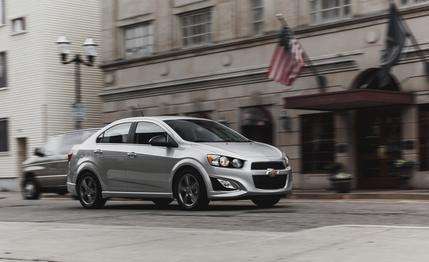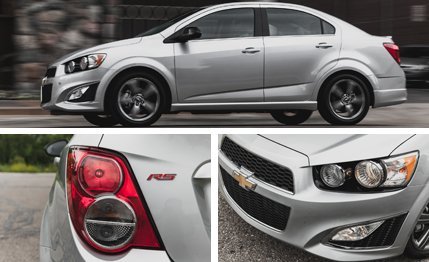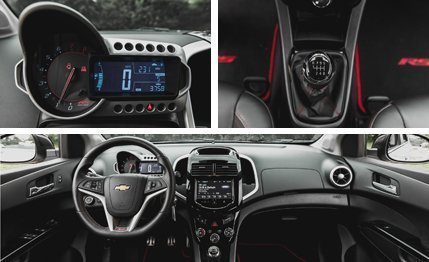 Instrumented Test
Instrumented Test
Chevrolet offers the Sonic with the optional 138-hp, 1.4-liter turbo four on LT and LTZ trims but makes the little huffer standard in the sporty RS package. Midway through the 2014 model year, Chevrolet added the RS package to the sedan; it had been hatchback only when it arrived for 2013. This demonstrates that, besides figuring out at long last how to build a decent small car and even assemble it in the United States, GM has found a way to give the market something fresh for a third model year.
Also new for mid-2014 is the Advanced Safety package of forward-collision alert and lane-departure warning, which added $395 to our Sonic RS sedan for an as-tested total of $20,925. It was the only extra-cost option, so the sticker price still came in at less than $21,000.
The RS standard equipment list is pretty strong, with A/C, a leather-wrapped steering wheel with a tilting-and-telescoping column, remote keyless entry, a rearview camera, and the Chevy MyLink infotainment system with voice recognition. If you access apps on your smartphone via the Bluetooth link, the MyLink touch screen displays navigation, Pandora, and other features. This car didn’t have the 4G LTE Wi-Fi hotspot link to the internet, but the Sonic will include that with 2015 models. So the “keep it fresh” mentality is continuing into a fourth year.

We were impressed with the Sonic when it first appeared for 2012—it finished second that year in a six-way subcompact shootout with the Honda Fit, Nissan Versa, Toyota Yaris, Hyundai Accent, and Kia Rio—and it still rides high with consumers as one of the sales leaders in the subcompact segment. Expect revisions as the 2015 models roll out, but a small Chevy that ranks high in its segment and gains market share year after year is emphatically not what critics expected in 2010.
Great Expectations
The sporty RS draws fewer raves than the Sonic does in general, mostly because the badge raises expectations beyond the car’s actual reach. Clearly, the RS does not aim to combat the likes of the Ford Fiesta ST or even the Kia Forte Koup turbo in performance, specification, or, to be fair, price.
As in the hatchback, the RS sedan employs the 1.4-liter Ecotec turbo four-banger but gets no more thrust: 138 horsepower is the Sonic ceiling, whether from the base 1.8-liter naturally aspirated four or the turbo 1.4. The latter has a broader torque band with a stronger peak (148 lb-ft at 2500 rpm versus 125 at 3800 rpm) and identical overall EPA mileage ratings, so we think it’s worth the $700 uptick.
Coupled here to a six-speed manual transmission, the 1.4-liter is strong enough to outrun the non-performance-grade versions of all the aforementioned competitors to 60 mph. The RS sedan clocked 8.2 seconds, 0.1 second behind the 2013 hatchback RS and identical to the time we got in a 2012 LTZ with the turbo-and-manual combination. This parity is despite what, in theory, should be a more accelerative combination of final drive and closer spacing between the gear ratios. Whereas most turbo Sonics run a 3.65:1 final drive with the manual (3.23:1 with the six-speed automatic), the RS gets a shorter 4.18:1 differential ratio (3.53:1 with the automatic). The manual uses a shorter first gear, too, but aside from making it easier to squeal the tires from a standstill, it means very little. At the drag strip, the LTZ turbo-and-manual hatchback turned a 16.5-second quarter-mile at 85 mph, and the RS sedan got there 0.1 second quicker going 1 mph faster. Even the 0-to-30 time doesn’t improve. Perhaps Chevy could save some bucks and use just one setup? Regardless, the most measurable effect of the gearing changes might be fuel economy. Sixth gear isn’t quite as tall as in other models (0.74:1 versus 0.61), and with the shorter final drive, we saw 29 mpg in the RS, whereas the LTZ returned 31 mpg.

We’ve grown a little more jaded about the Sonic as the B-segment fun-to-drive quotient expands with new entries featuring sharper, more responsive driving dynamics. The Sonic’s manual shifter isn’t the best tool in the subcompact shed anymore, the car’s steering is quick but short on feedback, and handling is predictable but not sprightly.
Hitting the Scales
Newer, more expressive designs also cast a distinct Elmer Fudd–ish shadow over the Sonic’s micro-Cruze styling. The resemblance to its larger stablemates is more than skin-deep. At 2846 pounds on our scale, this RS sedan weighs some 220 more pounds than a similarly sized Ford Fiesta SFE sedan. Steering clear of the more serious performance end of the B-segment spectrum seems wise. In that context, the weight penalty would loom larger, and the advantages of size (a trunk more spacious than the one in the Honda Civic, for starters, and habitable rear seats) would matter less. As it is, the 168-foot stopping distance from 70 mph and 0.85 g cornering could be better were the chassis lighter.
Putting the RS trimmings on the sedan, then, is rather like that string of pearls granny used to wear with a housedress. It classes things up a bit without really fooling anyone into thinking you’re headed to town in a ball gown. In a segment where the lowly Aveo once roamed the land in its Kmart wardrobe, the Sonic RS offers decent appearance upgrades. With 17-inch wheels, a decklid spoiler, front fog lamps, a more aggressive front fascia with an air dam, and body-side moldings, it looks a tad sportier on its lowered, stiffened suspension. The RS interior upgrades include a set of leather-trimmed, heated bucket seats with suedelike microfiber inserts up front and red stitching, plus a leather-dressed shift knob. Add those collision and lane-departure warning systems and drop a few more bucks on phone apps, and the Sonic RS driver needn’t feel deprived. That’s more than you could say for generations of previous small Chevys. Let’s hope the next step—making the driver feel special when the gas pedal is pressed—comes soon.